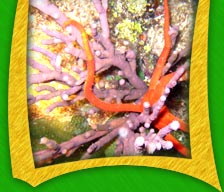|
Keep these fun facts and
tips handy for your next trip under the sea:
- Corals get their brilliant colors from marine algae that live
within their tissues, also known as zooxanthellae (pronounced
zoe-zan-thel-ee)
- White out! Prolonged, high water temperatures
can cause zooxanthellae to leave corals. When this happens, corals
may appear white or “bleached.”
- They may look potentially painful, but Diadema antillerum or
long-spined sea urchins are a coral’s best friend. Corals
grow slowly and require a special balance of space and sunlight
to survive. Fortunately, these prickly ocean herbivores consume
harmful macro-algae has the potential to outgrow, envelop, and
kill the coral.
- Once dominant on Florida’s reefs, Staghorn
(Acropora cervicornis) and
Elkhorn (Acropora palmata) corals are now listed as a
threatened species on the federal endangered species list.
- In an effort to restore dwindling coral reef habitats, scientists
help corals reproduce through an asexual process known as fragmentation.
Here, large pieces of stony coral are cut into small fragments
which are then attached to little hard discs using an environmentally-friendly
adhesive. These discs will later be transplanted to a reef site,
where the corals can expand and continue to grow.
- Life savers. Not the candy, the coral! Scientists believe marine
corals may hold the key to saving your life. Studies show that
organic materials derived from corals may help promote the re-growth
of long bones, inhibit cancer-cell division, and improve anti-HIV
medicines.
Resources for this article have been provided by
the Southeast
Florida Coral Reef Initiative, WIkipedia and
the Florida
Fish and Wildlife Conservation Commission.
|










